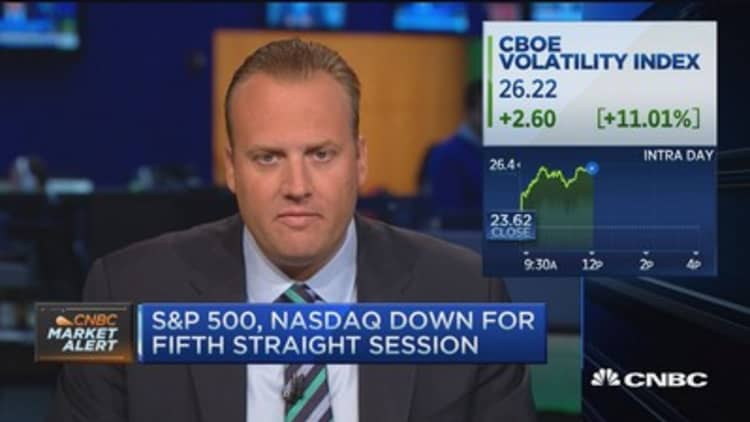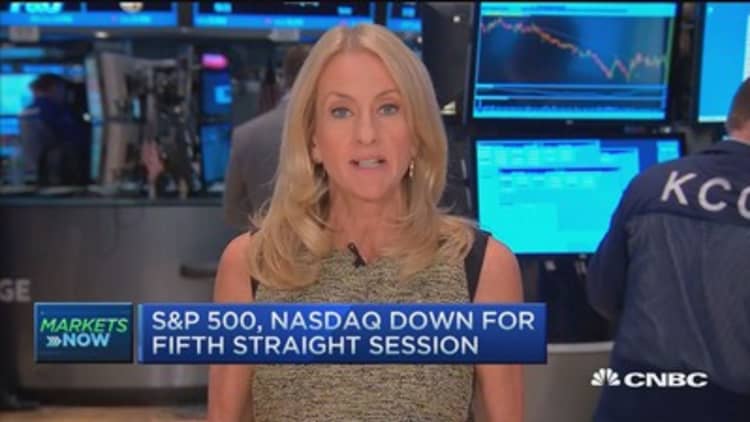


U.S. stocks closed sharply lower Monday as uncertainty about the timing of a rate hike and concerns about global economic growth continued to weigh on sentiment. (Tweet This)
The S&P 500 closed down about 2.5 percent, falling below the psychologically key level of 1,900 for the first time since Aug. 26. Health care fell more than 4 percent as the greatest decliner.
The Dow Jones industrial average closed near session lows, off about 312 points, but holding just above the psychologically key 16,000 level. Earlier, the index dipped below 16,000 for the first time since Sept. 1. The last close under that level was on Aug. 25.
Goldman Sachs plunged nearly 3.8 percent as the greatest weight on the blue chip index. The Dow and S&P are on track for their worst quarter in four years.
Apple closed nearly 2 percent lower despite news that it sold more than 13 million units of the new iPhone 6s and 6s Plus models in a record first weekend of sales.
The Nasdaq composite closed down 3 percent, pressured by a 6.3 percent decline in the iShares Nasdaq biotechnology ETF (IBB). The ETF fell further into bear market territory, or more than 20 percent from its 52-week high.
"I think it's a lot of panic. It's a lot of people who came in recently," said Paul Yook, portfolio manager at BioShares Funds. "In hindsight clearly the market did not price in this political risk."
Shares of Valeant closed down nearly 17 percent amid news that Democrats are pressing a Republican committee chairman to tied to a price hike from earlier this year.
Hillary Clinton's tweet last Monday on drug "price gouging" pressured IBB for its worst day of the year. The declines continued throughout the week, with IBB plunging nearly 5 percent Friday for its worst day since August 2014. The Dow closed more than 100 percent higher, boosted by solid earnings.
"I think (because) we're a few days ahead of the quarter close, people want to close out of some losers. It looks like momentum selling," said Mike Bailey, director of research at FBB Capital Partners.
Read MoreJPMorgan: Buy into the biotech bear market
"The big concern here is the market has deteriorated to a point that now even the leadership is faltering," said Lance Roberts, head of Streettalklive.com.
The Nasdaq composite became the last of the three major averages to flash a death cross, in which the 50-day moving average falls below the 200-day. The index is on track for its worst quarter in about three years.
The Russell 2000 fell below the low hit in late August.
"The fact that the Russell already broke down to me suggests the path of least resistance is lower," said Adam Sarhan, CEO of Sarhan Capital.
All three major averages traded in correction territory, or more than 10 percent below their 52-week highs.
"So far we're in a correction phase and I don't want to make more of it than that," said Bruce Bittles, chief investment strategist at RW Baird. "Investors have to be cautious here and wait for the market to prove itself and not try to pick bottoms."
Investors continued to digest remarks from Fed speakers for indications on the timing of a rate hike.
New York Fed President William Dudley said the central bank will , Dow Jones reported. He noted international events have created uncertainty about the U.S. outlook.
"I think the biggest focus remains Fed uncertainty. You hear Dudley saying, uncertainty about the outlook can't be eliminated," said Peter Cardillo, chief market economist at Rockwell Global Capital.
"The Fed has created this wall of uncertainty even as we get good economic data," he said.
Read MoreFed, jobs could drop more rate clues in week ahead
Chicago Fed President Charles Evans said in prepared remarks a later liftoff would better help the U.S. economy navigate through uncertain economic trends.
Ahead of Friday's key employment report, August personal income data showed an increase of 0.3 percent in personal income and a 0.4 percent increase in consumer spending, roughly in-line with estimates.
"What's a little concerning is Janet Yellen did speak last week and she made it pretty clear that she wants to raise rates," said Patrick Maldari, fixed income manager at Aberdeen Asset Management.
"The underlying growth rate is below long-term trends. I think we should be positioned for rates to be lower for a lot longer," he said.
Treasury yields trimmed losses, with the 10-year yield at 2.10 percent and the near 0.66 percent.
The U.S. dollar reversed to trade mildly lower, with the euro above $1.12 and the yen at 119.91 yen against the greenback.
August pending home sales posted a decline of 1.4 percent, missing expectations of a slight gain. Pending home sales are still 6.1 percent from a year ago.
The September Dallas Fed Survey showed manufacturing activity was flat.
"If you're looking for good news, you've got it (in good personal income data)," said Art Hogan, chief market strategist at Wunderlich Securities. "The unfortunate thing is we have two major things in front of us that haven't changed: When does the Fed raise rates? When does China bottom?"
"We've got a market that's found a path of least resistance to the downside," he said.
Asian markets closed mixed on Monday as data from China showed industrial profits declined 8.7 percent in August from a year earlier, the largest drop since 2011.
European markets closed about 2 percent lower, pressured by continued concerns about Glencore and Volkswagen. Shares of Glencore closed nearly 30 percent lower in London.
Commodities weighed, with crude down more than 2.5 percent and copper off more than 1.5 percent.
Earlier, the Dow futures were about 100 points lower — reversing early gains and pointing to a lower open for the blue-chip U.S. stock index.
"Outside of the U.S. there may be better absolute growth opportunities but the economies there are deteriorating and weakening much faster than the U.S. is doing," said Nick Raich, CEO of The Earnings Scout.
Major U.S. Indexes
Investors also kept an eye on Washington, where the federal government faces a deadline on a new budget. If unresolved, the government would shut down as of Thursday. House Speaker John Boehner resigned on Friday as speaker and from Congress.
Read MoreEarly movers: AA, MEG, WMB, BHI, VOD, NVO, FB, JCP, SNY & more
The Dow Jones Industrial Average closed down 312.78 points, or 1.92 percent, at 16,001, with Visa leading decliners and Johnson & Johnson eking out a slight gain.
The Dow transports fell more than 2 percent, with Avis Budget and JetBlue leading all constituents lower.
The closed down 49.57 points, or 2.57 percent, at 1,881.77, with health care leading all 10 sectors lower.
The Nasdaq closed down 142.97 points, or 3.04 percent, at 4,543.97.
The CBOE Volatility Index (VIX), widely considered the best gauge of fear in the market, traded above 27.
About nine stocks declined for every advancer on the New York Stock Exchange, with an exchange volume of 1.05 billion and a composite volume of nearly 4.3 billion in the close.
Crude oil futures for November delivery settled down $1.27, or 2.78 percent, at $44.43 a barrel on the New York Mercantile Exchange. Gold futures settled down $13.90 at $1,131.70 an ounce.
On tap this week:
Monday
5 p.m.: San Francisco Fed President John Williams
Tuesday
Midnight deadline for Congress to approve budget
9 a.m.: S&P/Case-Shiller home prices
10 a.m.: Consumer confidence
Wednesday
8 a.m.: New York Fed's Dudley on market liquidity
8:15 a.m.: ADP employment
9:45 a.m.: Chicago PMI
3 p.m.: Fed Chair Janet Yellen welcoming remarks at St. Louis Fed event
3:10 p.m.: St. Louis Fed President James Bullard at St. Louis Fed community banking event
8:15 p.m.: Fed Gov. Lael Brainard at St. Louis Fed event
Thursday
September vehicle sales
8:30 a.m.: Initial claims
9:45 a.m.: Manufacturing PMI
10 a.m.: ISM manufacturing; construction spending
2:30 p.m.: St. Francisco Fed's Williams on outlook
Friday
8:30 a.m.: Employment; Boston Fed President Eric Rosengren at Boston Fed conference
9 a.m.: Minneapolis Fed President Narayan Kocherlakota
10 a.m.: Factory orders
11 a.m.: Cleveland Fed President Loretta Mester
1:30 p.m.: Fed Vice Chair Stanley Fischer on monetary policy at Boston Fed
More From CNBC.com:


